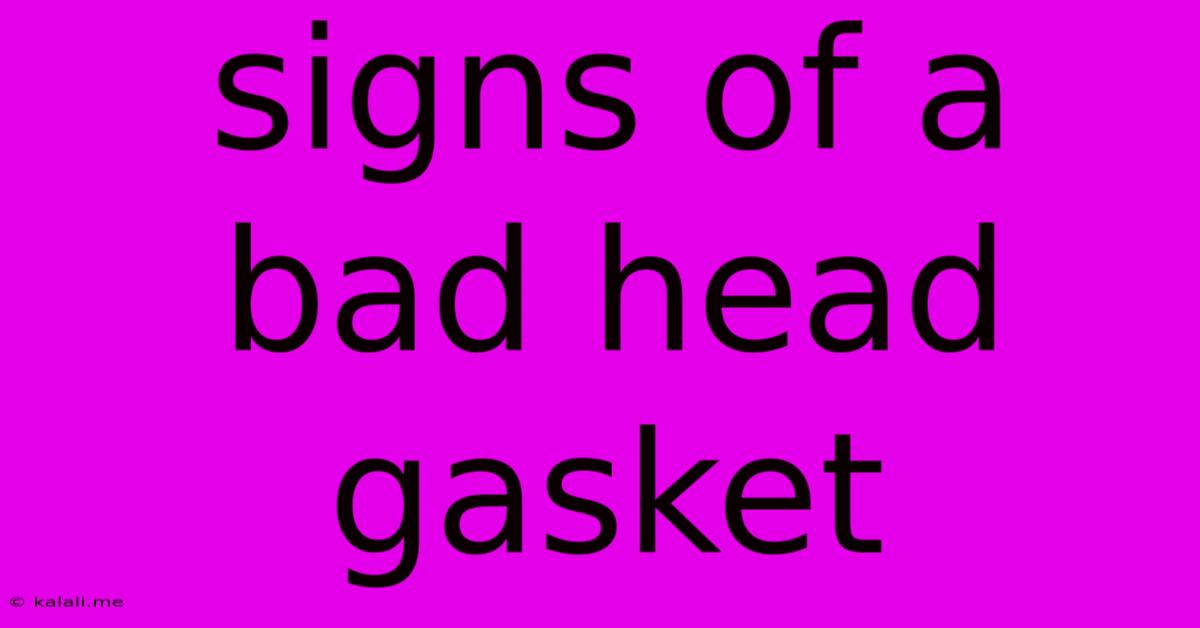Signs Of A Bad Head Gasket
Kalali
May 23, 2025 · 3 min read

Table of Contents
Signs Your Head Gasket is About to Fail: Don't Ignore These Warning Signals!
A blown head gasket is a serious automotive problem that can lead to costly repairs if ignored. This article will guide you through the common signs indicating a failing head gasket, helping you identify the issue early and prevent further engine damage. Ignoring these warning signs can lead to catastrophic engine failure, so understanding the symptoms is crucial for car owners.
Understanding the Head Gasket's Role
Before diving into the symptoms, it's important to briefly understand the head gasket's function. This crucial component seals the gap between the engine block and the cylinder head, preventing coolant and oil from mixing. A compromised head gasket allows these vital fluids to intermingle, resulting in serious engine problems.
Key Symptoms of a Failing Head Gasket:
Several warning signs can indicate a failing or blown head gasket. These symptoms can manifest individually or in combination. Pay close attention to these indicators:
-
White Exhaust Smoke: This is often the most noticeable sign. White smoke, especially when the engine is cold or idling, indicates coolant leaking into the combustion chamber. The steam from the coolant creates this characteristic smoke. Thick, persistent white smoke is a strong indicator of a head gasket issue.
-
Overheating Engine: A failing head gasket can disrupt the coolant's ability to effectively cool the engine. Consequently, the engine temperature gauge will often climb significantly, potentially triggering an overheating warning light. This is a serious issue that can cause severe engine damage if not addressed promptly.
-
Coolant Loss: Regularly checking your coolant level is vital. A steadily decreasing coolant level without any visible leaks suggests the coolant might be leaking into the engine block through a compromised head gasket. This loss can be gradual or rapid, depending on the extent of the damage.
-
Oil Contamination: Inspect your engine oil. Milky or frothy oil is a clear sign of coolant mixing with the oil, a telltale sign of a blown head gasket. The coolant's presence changes the oil's consistency and appearance.
-
Loss of Compression: A blown head gasket can compromise the compression within the cylinders. This can result in a noticeable loss of engine power, difficulty starting, or rough running. This is often accompanied by other symptoms.
-
External Coolant Leaks: While less directly indicative of an internal head gasket failure, external coolant leaks around the head gasket area can be an early warning sign. Look for wet patches or puddles of coolant under your car.
-
Sweet Smell from Exhaust: Coolant has a distinctive sweet odor. If you notice an unusually sweet smell emanating from your exhaust pipe, it could suggest coolant is leaking into the combustion chamber. This is often subtle and easily overlooked.
-
Bubbles in Radiator: With the engine running, carefully observe your radiator. Bubbles rising to the surface can indicate combustion gases are entering the cooling system, a characteristic symptom of a head gasket failure.
What to Do If You Suspect a Head Gasket Problem:
If you notice any of these symptoms, it’s crucial to have your vehicle inspected by a qualified mechanic immediately. Delaying repairs can lead to irreversible engine damage, resulting in extensive and costly repairs. Driving with a blown head gasket can also lead to overheating, which can cause further damage to your engine.
Disclaimer: This article is for informational purposes only and should not be considered professional automotive advice. Always consult with a qualified mechanic for accurate diagnosis and repair of any vehicle issue.
Latest Posts
Latest Posts
-
How To Get The File Menu In Ubuntu 22 04
May 23, 2025
-
How To Stop The Automatic Enrollment Notifications On A Mac
May 23, 2025
-
He Who Shall Not Be Named
May 23, 2025
-
Can You Mix Latex And Acrylic Paint
May 23, 2025
-
Do I Need Plastic Behind Cement Board
May 23, 2025
Related Post
Thank you for visiting our website which covers about Signs Of A Bad Head Gasket . We hope the information provided has been useful to you. Feel free to contact us if you have any questions or need further assistance. See you next time and don't miss to bookmark.